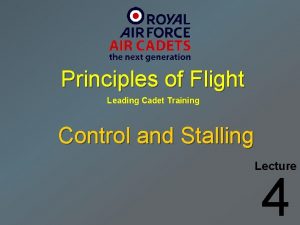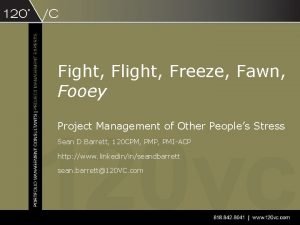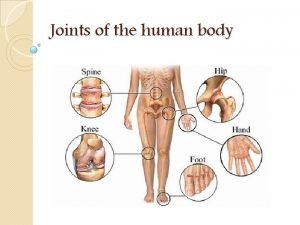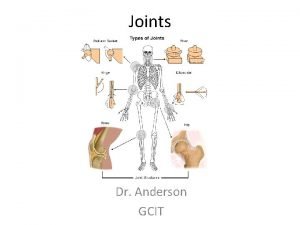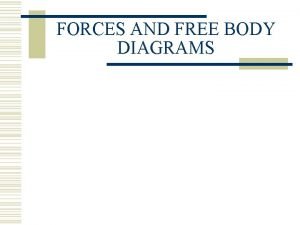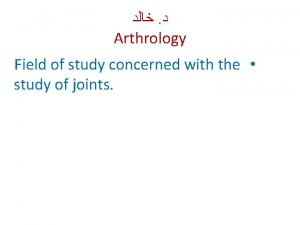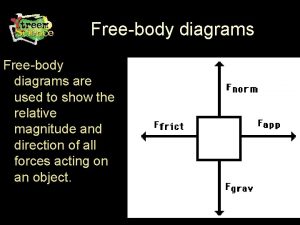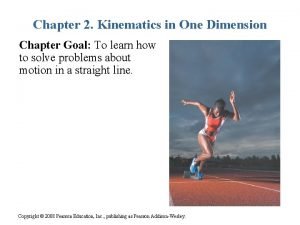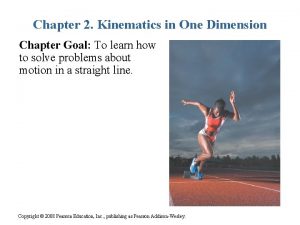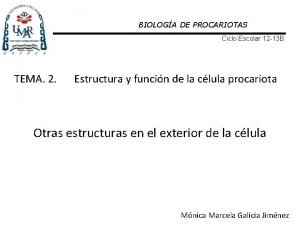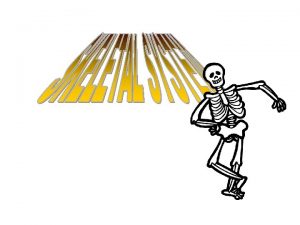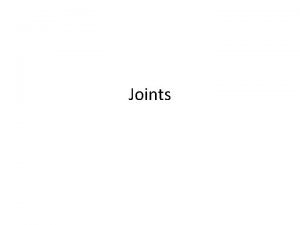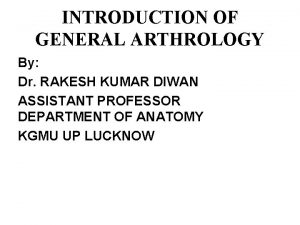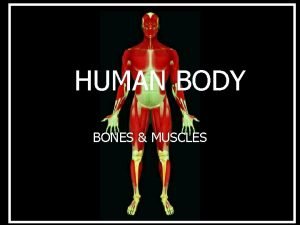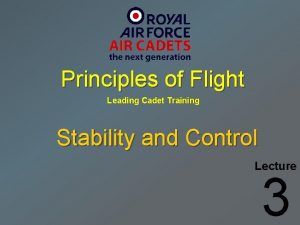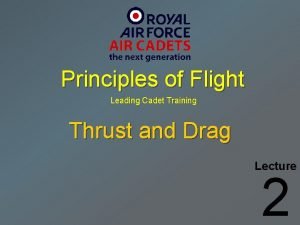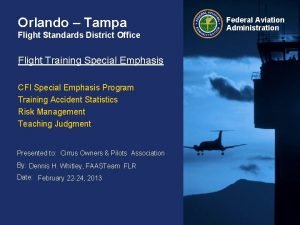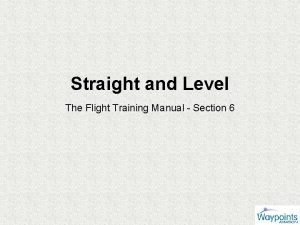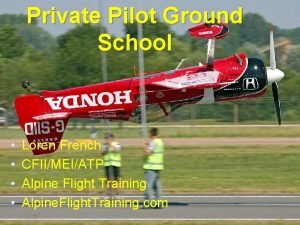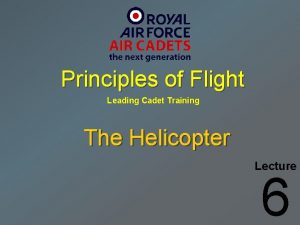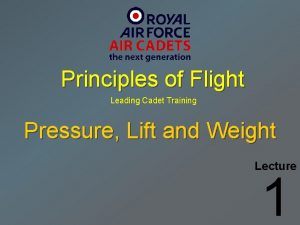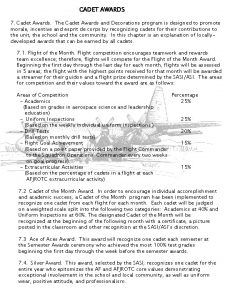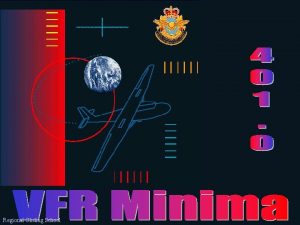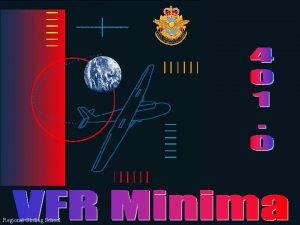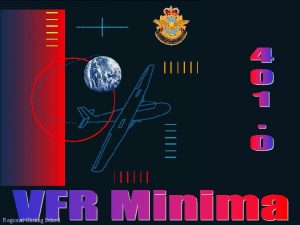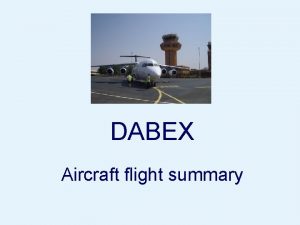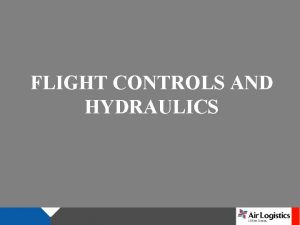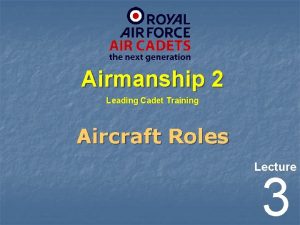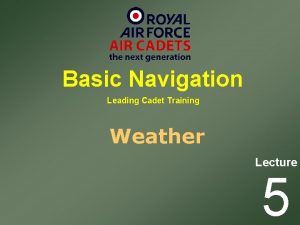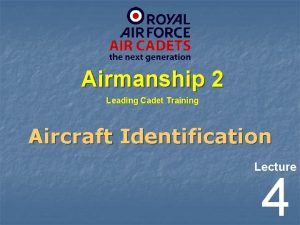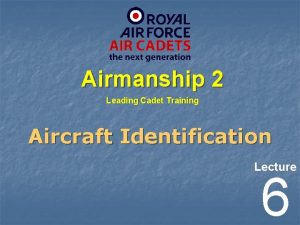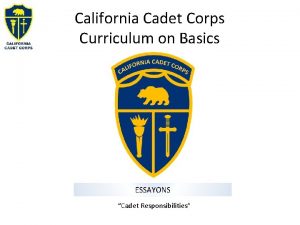Principles of Flight Leading Cadet Training Gliding Lecture


























- Slides: 26

Principles of Flight Leading Cadet Training Gliding Lecture 5

Balance of Forces In straight and level flight, at constant speed, two pairs of forces act on the aircraft. Thrust opposes Drag and Lift opposes Weight. LIFT DRAG THRUST WEIGHT

Balance of Forces To maintain a steady airspeed if thrust is removed, pitch the nose down and use weight to descend. The aircraft is now GLIDING. LIFT DRAG THRUST WEIGHT

Balance of Forces Lift Speed If If the Nose is islowered, raised, What happens to Lift and Speed? Lift reduce. Lift and Speed increase. The alsoreduces! increases! Ascent also The Rate of of Descent ?

Forces on a Glider Only three forces act on a Glider – Due to Gravity a glider descends in a controlled way. Drag acts along the flightpath, and as the glider descends, air flow produces Lift. There is NO Thrust Lift Drag Path of Glider Weight

Forces on a Glider The Lift reduces the rate of descent, and to increase airspeed the nose must be lowered. So in order to maintain steady flight the glider must be constantly descending. Lift Drag Path of Glider Weight

Forces on a Glider Remember: If you fly too slowly Lift will be lost and the glider will Stall. If you fly too fast the Rate of Descent will be High. Lift Drag Path of Glider Weight

How Far will a Glider go ? This depends upon the gliding angle and the wind. The flatter the gliding angle the further the glider will travel. A glider with a steep angle does not travel far. A glider with a shallow angle travels much further.

How Far will a Glider go ? This depends upon the gliding angle and the wind. The flatter the gliding angle the further the glider will travel. This angle is least when the ratio of lift to drag is at its highest. i. e. maximum lift and minimum drag

How Far will a Glider go ? A Viking Glider’s angle is about 1 in 35. Therefore, from a height of 3, 280 ft (1 kilometre), in still air, it will travel about 35 kilometres

How Far will a Glider go ? Equally, a glider travelling downwind, will cover a greater distance over the ground than a glider travelling into the wind. Upwind Downwind

How Far will a Glider go ? A glider with a flying speed of 35 kts flies into a head wind of 35 kts. To an observer on the ground the glider will appear to lose height slowly over one spot Because the glider is constantly descending. Wind 35 kts Speed 35 kts

Air Brakes Most gliders do not have Flaps in their wings. Instead they are fitted with airbrakes. Airbrakes are panels which lie in the wings, and can extend to 90° from the upper and/or lower surfaces of the wings

Air Brakes Airbrakes are used when approaching to land A glider with Airbrakes IN. A glider with Airbrakes OUT produces more drag and must therefore lower the nose to maintain airspeed = Steeper Descent + Shorter Ground Distance

Check of Understanding What are three forces acting on a glider during normal flight? Drag, Weight and Thrust Lift, Weight and Drag, Thrust and Lift, Weight and Thrust

Check of Understanding What is the action of airbrakes on the wings of a glider designed to do? Increase lift and reduce drag Reduce lift and reduce drag Increase lift and increase drag Reduce lift and increase drag

Check of Understanding When would a glider pilot use airbrakes? When wanting to turn When wanting to climb When approaching to land When being winch-launched

Check of Understanding A glider with a flying speed of 20 kts flies into a head wind of 20 kts. To an observer on the ground the glider will appear to? Lose height slowly over one spot Cover the ground at 20 kts Climb steadily Cover the ground at 10 kts

Check of Understanding The flatter the gliding angle of a glider, the further the glider will travel over the ground. This angle is least when the ratio of lift to drag is: Equal to zero At its lowest Equal to 35 At its highest

Check of Understanding Glider A is travelling downwind and glider B is travelling into wind. The indicated airspeed, angle of attack and gliding angle are the same for both gliders. Therefore: Glider A will travel further than Glider B Both will travel the same distance Glider B will travel further than Glider A The difference cannot be determined

Check of Understanding During flight if the nose of a glider is lowered, what happens to Lift and Speed? Both lift and speed decrease Lift increases, speed decreases Lift decreases, speed increases Both lift and speed increase

Check of Understanding How does a glider pilot increase airspeed? Push the stick forward to raise the nose Pull the stick back to raise the nose Push the stick forward to lower the nose Pull the stick back to lower the nose

Check of Understanding When flying into a Headwind, the distance covered over the ground will: Decrease Remain the same Increase Be the square of the height

Check of Understanding A Viking glider descends from 1640 ft (0. 5 km). How far over the ground does it travel (in still air)? 70 kms 35 kms 17. 5 kms 8. 75 kms

Check of Understanding In order to maintain steady flight what must a glider be constantly doing? Descending Spiralling Ascending Travelling upwind

Principles of Flight Leading Cadet Training End of Presentation
 Principles of flight air cadets
Principles of flight air cadets Objectives of roving frame
Objectives of roving frame Flight flight freeze fawn
Flight flight freeze fawn 01:640:244 lecture notes - lecture 15: plat, idah, farad
01:640:244 lecture notes - lecture 15: plat, idah, farad Pef ecografia
Pef ecografia What are gliding movements
What are gliding movements What are gliding movements
What are gliding movements They are called gliding vowels.
They are called gliding vowels. A football is moving upwards towards its peak
A football is moving upwards towards its peak Arthrology is the study of
Arthrology is the study of A flying squirrel is gliding (no wing flaps)
A flying squirrel is gliding (no wing flaps) A skier is gliding along at 3m/s
A skier is gliding along at 3m/s Rasp gliding forecast
Rasp gliding forecast Gliding joints
Gliding joints A skier is gliding along at 3m/s
A skier is gliding along at 3m/s Gliding motility
Gliding motility Gliding joints
Gliding joints Classification of joints
Classification of joints Gliding movement
Gliding movement Ball and socket joint
Ball and socket joint Chapter 5 principles of voice leading answers
Chapter 5 principles of voice leading answers Principles of flight air cadets
Principles of flight air cadets Principles of flight air cadets
Principles of flight air cadets Alien student flight program
Alien student flight program Tampa fsdo office
Tampa fsdo office How to maintain straight and level flight
How to maintain straight and level flight Indicated altitude
Indicated altitude
